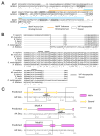GCN5L1/BLOS1 Links Acetylation, Organelle Remodeling, and Metabolism
- PMID: 29477615
- PMCID: PMC5912981
- DOI: 10.1016/j.tcb.2018.01.007
GCN5L1/BLOS1 Links Acetylation, Organelle Remodeling, and Metabolism
Abstract
General control of amino acid synthesis 5 (GCN5) like-1 (GCN5L1) was identified as a novel gene with sequence homology to the histone acetyltransferase Gcn5. Subsequent protein-interaction studies identified GCN5L1 as a subunit of the multiprotein lysosome biogenesis complex, resulting in an alternative designation as biogenesis of lysosome-related organelle complex 1 subunit 1 (BLOS1 or BLOC1S1). Despite the distinct nomenclatures, GCN5L1/BLOS1 has been shown to play crucial roles in mitochondria, endosomes, lysosomes, and synaptic vesicle precursors (SVPs). GCN5L1/BLOS1 controls mitochondrial protein acetylation, modulates metabolic pathways, and orchestrates retrograde mitochondria-to-nucleus signaling. It also contributes to endosome-lysosome and vesicle trafficking and to endolysosomal function. Here we discuss the intracellular roles of GCN5L1/BLOS1 in the hope of linking mitochondria-centric effects to cytosolic vesicle biology.
Keywords: BORC complex; endosomal function; lysosome trafficking; mitochondria; retrograde signaling.
Copyright © 2018 Elsevier Ltd. All rights reserved.
Conflict of interest statement
No conflicts
Figures



Similar articles
-
The emerging roles of GCN5L1 in mitochondrial and vacuolar organelle biology.Biochim Biophys Acta Gene Regul Mech. 2021 Feb;1864(2):194598. doi: 10.1016/j.bbagrm.2020.194598. Epub 2020 Jun 26. Biochim Biophys Acta Gene Regul Mech. 2021. PMID: 32599084 Free PMC article. Review.
-
GCN5L1 interacts with αTAT1 and RanBP2 to regulate hepatic α-tubulin acetylation and lysosome trafficking.J Cell Sci. 2018 Nov 20;131(22):jcs221036. doi: 10.1242/jcs.221036. J Cell Sci. 2018. PMID: 30333138 Free PMC article.
-
Biogenesis of lysosome-related organelles complex-1 subunit 1 (BLOS1) interacts with sorting nexin 2 and the endosomal sorting complex required for transport-I (ESCRT-I) component TSG101 to mediate the sorting of epidermal growth factor receptor into endosomal compartments.J Biol Chem. 2014 Oct 17;289(42):29180-94. doi: 10.1074/jbc.M114.576561. Epub 2014 Sep 2. J Biol Chem. 2014. PMID: 25183008 Free PMC article.
-
BLOC1S1/GCN5L1/BORCS1 is a critical mediator for the initiation of autolysosomal tubulation.Autophagy. 2021 Nov;17(11):3707-3724. doi: 10.1080/15548627.2021.1894759. Epub 2021 Mar 11. Autophagy. 2021. PMID: 33629936 Free PMC article.
-
The Overcrowded Crossroads: Mitochondria, Alpha-Synuclein, and the Endo-Lysosomal System Interaction in Parkinson's Disease.Int J Mol Sci. 2019 Oct 25;20(21):5312. doi: 10.3390/ijms20215312. Int J Mol Sci. 2019. PMID: 31731450 Free PMC article. Review.
Cited by
-
Mitochondrial General Control of Amino Acid Synthesis 5 Like 1 Regulates Glutaminolysis, Mammalian Target of Rapamycin Complex 1 Activity, and Murine Liver Regeneration.Hepatology. 2020 Feb;71(2):643-657. doi: 10.1002/hep.30876. Epub 2019 Oct 17. Hepatology. 2020. PMID: 31344750 Free PMC article.
-
BLOC1S1 control of vacuolar organelle fidelity modulates TH2 cell immunity and allergy susceptibility.bioRxiv [Preprint]. 2024 Mar 27:2024.03.21.586144. doi: 10.1101/2024.03.21.586144. bioRxiv. 2024. Update in: Allergy. 2025 Aug;80(8):2128-2140. doi: 10.1111/all.16461. PMID: 39803487 Free PMC article. Updated. Preprint.
-
General Control of Amino Acid Synthesis 5-Like 1-Mediated Acetylation of Manganese Superoxide Dismutase Regulates Oxidative Stress in Diabetic Kidney Disease.Oxid Med Cell Longev. 2021 Feb 17;2021:6691226. doi: 10.1155/2021/6691226. eCollection 2021. Oxid Med Cell Longev. 2021. PMID: 33680286 Free PMC article.
-
GCN5L1-mediated acetylation prevents Rictor degradation in cardiac cells after hypoxic stress.Cell Signal. 2024 Apr;116:111065. doi: 10.1016/j.cellsig.2024.111065. Epub 2024 Jan 26. Cell Signal. 2024. PMID: 38281616 Free PMC article.
-
Mitochondrial CypD Acetylation Promotes Endothelial Dysfunction and Hypertension.Circ Res. 2024 May 24;134(11):1451-1464. doi: 10.1161/CIRCRESAHA.123.323596. Epub 2024 Apr 19. Circ Res. 2024. PMID: 38639088 Free PMC article.
References
-
- Thul PJ, et al. A subcellular map of the human proteome. Science. 2017;356(6340) - PubMed
-
- Inoue M, et al. Isolation and characterization of a human cDNA clone (GCN5L1) homologous to GCN5, a yeast transcription activator. Cytogenet Cell Genet. 1996;73(1–2):134–6. - PubMed
-
- Driessen CA, et al. Cloning and structural analysis of the murine GCN5L1 gene. Gene. 1997;203(1):27–31. - PubMed
-
- Watanabe TK, et al. Molecular cloning of a novel human cDNA, RT14, containing a putative ORF highly conserved between human, fruit fly, and nematode. DNA Res. 1995;2(5):235–7. - PubMed
-
- Starcevic M, Dell’Angelica EC. Identification of snapin and three novel proteins (BLOS1, BLOS2, and BLOS3/reduced pigmentation) as subunits of biogenesis of lysosome-related organelles complex-1 (BLOC-1) J Biol Chem. 2004;279(27):28393–401. - PubMed
Publication types
MeSH terms
Substances
Grants and funding
LinkOut - more resources
Full Text Sources
Other Literature Sources

